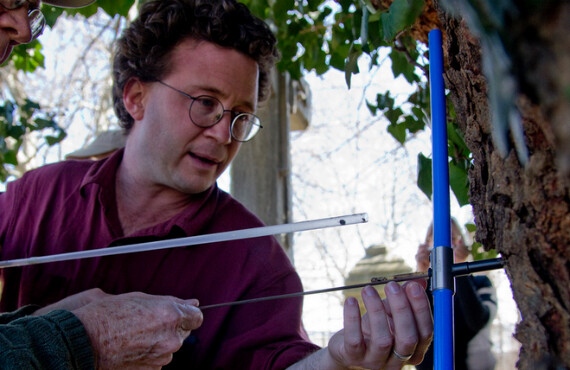Penn’s David Hewitt Helps Philadelphia Design Parks Agile Enough to Adapt
On a Wednesday afternoon in the Cobbs Creek Environmental Education Center, a group gathered around a large table covered in maps and photos. Consisting of land managers, biologists, academics, environmental consultants, students and community members, the group was there to brainstorm new ways of managing some of Philadelphia’s 5,600 acres of natural space.
The meeting, called a charette, is part of a unique planning process that the City of Philadelphia’s Department of Parks and Recreation is embarking on this year. While the department has always regularly reassessed and rewritten its master plans for land management, this time around, something new is being tried. And the University of Pennsylvania’s David Hewitt is helping do it.
Hewitt, a Penn alumnus, is a lecturer in the School of Arts & Sciences’ Department of Biology and in the School of Design, where for the past two years he has taught a course on ecological principles for planners. Trained as a botanist and evolutionary biologist, Hewitt can often be found educating others about nature. In addition to his work at Penn, Hewitt has appointments at the Academy of Natural Sciences of Drexel University and the Wagner Free Institute of Science and has been involved in teaching and outreach with many other organizations locally and nationally.
It was through this broad network that Hewitt began working with Philadelphia Parks and Recreation to develop a new kind of land management plan for the city.
Traditionally, land managers in the United States have tried to maintain or restore ecosystems to be as “natural” as possible, a goal that usually means trying to make the land look like it did before European immigrants arrived. But, with climate change, invasive species, human activity and a host of other variables at play, it can be hard to predict how a given parcel of land will respond to management actions.
“In the face of all this uncertainty, land managers still have to move forward,” Hewitt says. “There’s not the option to say, ‘There are too many unknowns, and so we won’t do anything.’”
With its current planning process, Parks and Recreation is taking an open-minded tack, hoping to position itself to nimbly respond to evolving environments and changing community needs. The pilot site for the new approach is 30 acres in Cobbs Creek Park in West Philadelphia, with plans to expand to other parks around the city in the coming years.
“We’ve not approached planning like this before,” says Joan Blaustein, director of urban forestry and ecosystem management at Parks and Recreation. “We’re trying to anticipate changes and build in room to adapt.”
Community engagement — a central tenet of Penn President Amy Gutmann’s Penn Compact 2020 — is similarly key to the new Parks and Rec plan. To ensure residents’ voices are heard, Hewitt taught a Wagner Free Institute of Science course last spring to residents of the Cobbs Creek neighborhood as well as other Philadelphia residents to educate them in the fundamental principles of ecology and experimental design.
“We want to give them a grounding in the basic vocabulary of the field,” Hewitt says, “But the idea is not to teach facts, rather to teach them how to learn those facts.”
At the charette, course participants had the opportunity to apply this new understanding by proposing their management ideas for the Cobbs Creek forest in conversations with experts from Parks and Rec, the U.S. Forest Service and the U.S. Fish and Wildlife Service, as well as a number of academics and environmental consultants.
“Some questions will be straightforward, and others will be more widely experimental,” Hewitt says. “Take something like what tree is the best to plant. It’s an easy question to ask but a hard one to answer.”
Key to coming up with answers to such queries is monitoring. Ideally, researchers and managers would love to be able to have eyes everywhere, keeping tabs on the wildlife and plant species in every plot of land that falls under their purview. While this would be logistically and financially impossible for the city’s Parks and Recreation staff to take on alone, recruiting nature-loving community members helps the department extend its reach.
“A paid researcher can’t take the risk of spending three years studying something when the results might not be publishable,” Hewitt says. “But a neighbor who is walking through that park, taking a morning constitutional, can say, ‘I’m seeing this,’ much more easily.”
Hewitt envisions one day having online forums where local residents can log on and post photos of species they’ve spotted that day, be they birds, beetles or butterflies. Experts could then check the sites for anything noteworthy.
On-the-ground experiments in Cobbs Creek will begin in the spring. The managers will then take the approach elsewhere in the city, applying lessons learned while recognizing that, just as the ecology of each location is unique, so, too, are the expectations and desires of the neighborhood’s human inhabitants.
“Everything that is being done needs to be set within a cultural, social and ethical matrix that is different for each site,” Hewitt says.








